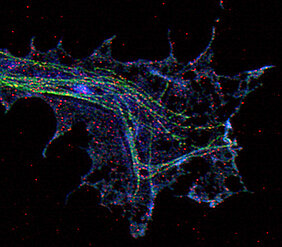New triggers of severe disorder pinpointed
07/25/2016Looking for the causes of amyotrophic lateral sclerosis (ALS), an international consortium has discovered two new disease genes. Scientists from the Institute of Clinical Neurobiology of the Würzburg university hospital contributed to the discovery.

Amyotrophic lateral sclerosis is a severe neurological disease that begins with muscle atrophy and paralysis in arms and legs. The paralysis gradually spreads to all muscles including the respiratory muscles, usually leading to death within a few years. The disease affects 1 in 400 persons worldwide. Famous patients such as astrophysicist Stephen Hawking or painter Jörg Immendorf, who died in May 2007 as a result of the disease, have raised public awareness of the disorder.
Eight million genetic variations
Looking for the disease triggers, an international team of researchers with Würzburg participation has now made a crucial discovery. The study comprised more than 15,000 ALS patients and 26,000 healthy controls. The scientists found over eight million genetic variations in the genetic material of the study subjects, distributed throughout the entire genome. Among those identified were two gene variations that are associated with a high risk of developing amyotrophic lateral sclerosis.
A working group led by Jan Veldink at the University of Utrecht, Netherlands, pinpointed the C21ORF2 gene as a new risk gene; another group headed by John Landers from the University of Massachusetts Medical School, Worchester, USA, identified the gene for the NEK1 kinase as another risk gene. Both works were published in the journal Nature Genetics on 25 July 2016.
Long-term research in Würzburg
"These mutations back previous research of the Würzburg working group at the Institute for Clinical Neurobiology," says Professor Michael Sendtner, Chair of the Department for Clinical Neurobiology and head of the institute that has been studying the inexorable death of the neurons for many years. Their activities centre on mechanisms that regulate the stability and regrowth of ultra-fine structures, the so-called microtubules, in the motor neurons responsible for movement. The NEK1 kinase assumes a central role in this context.
"The NEK1 kinase is a key regulator of the microtubules' dynamics that stabilise the axonal connections in motor neurons," Michael Sendtner explains. Microtubules are involved in maintaining the structure and shape of cells as well as the transport of important cell constituents, such as proteins and mitochondria, between the cell body and the neuromuscular synapse that transmits signals to the muscle fibres causing muscle contraction. "If microtubules malfunction, the axons will degenerate. At this point, it is only a matter of time until the entire cell will die," the scientists further. NEK1 organises the creation of new microtubules.
A target for new therapies
Back in 2014 already, the scientists were able to show that so-called neurotrophic factors, such as the ciliary neurotrophic factor (CNTF), impair the stability of the microtubules. These factors stimulate the differentiation of neurons and contribute to their survival. A signal molecule named STAT-3 is involved in the process. It interacts with Stathmin, a molecule capable of destabilising microtubules.
Stathmin in turn interacts with other filaments in the axons, the neurofilaments. They form aggregates in the axons of ALS patients as in other neurodegenerative diseases such as Alzheimer's which destabilise the microtubules. "Blocking Stathmin using specific active agents hence is a potential target for new therapies of motor neuron diseases and maybe for other neurodegenerative disorders as well," Michael Sendtner further.
Novel risk variants and genetic architecture in amyotrophic lateral sclerosis. Nature Genetics. 2016. DOI: 10.1038/ng.1622
NEK1 identified as novel risk gene in ALS. Nature Genetics. 2016.DOI:10.1038/ng.3626
Neurofilament depletion improves microtubule dynamics via modulation of Stat3/stathmin signaling. Acta Neuropathol. 2016. DOI: 10.1007/s00401-016-1564-y
Local axonal function of STAT3 rescues axon degeneration in the pmn model of motoneuron disease. The Journal of Cell Biology. 2014. DOI: 10.1083/jcb.201203109
Contact
Prof. Dr. Michael Sendtner, Phone: +49 931 201-44000, E-mail: Sendtner_M@klinik.uni-wuerzburg.de







